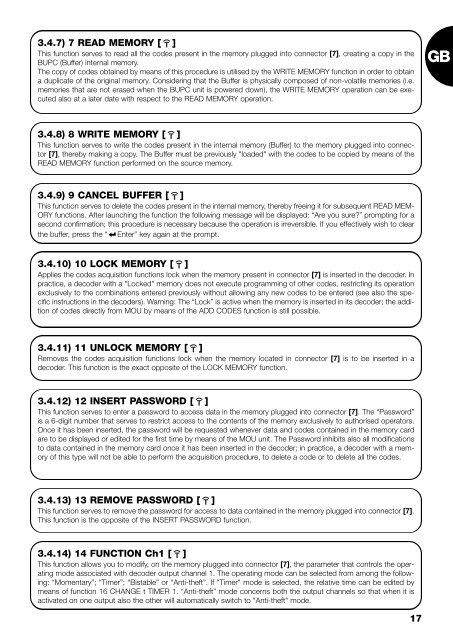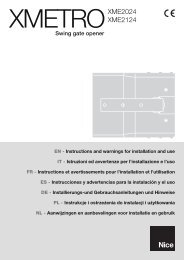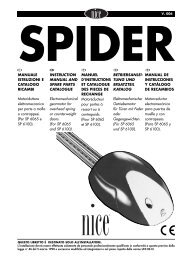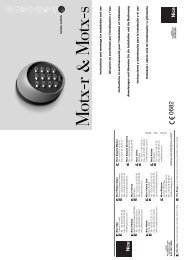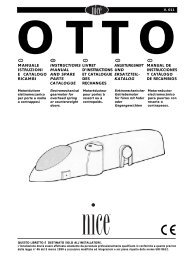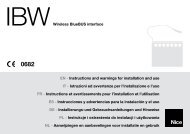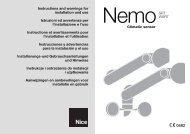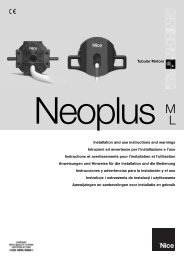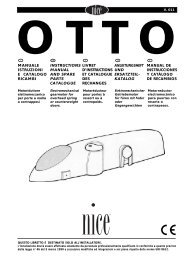F - Nice-service.com
F - Nice-service.com
F - Nice-service.com
- No tags were found...
Create successful ePaper yourself
Turn your PDF publications into a flip-book with our unique Google optimized e-Paper software.
3.4.7) 7 READ MEMORY [ T ]This function serves to read all the codes present in the memory plugged into connector [7], creating a copy in theBUPC (Buffer) internal memory.The copy of codes obtained by means of this procedure is utilised by the WRITE MEMORY function in order to obtaina duplicate of the original memory. Considering that the Buffer is physically <strong>com</strong>posed of non-volatile memories (i.e.memories that are not erased when the BUPC unit is powered down), the WRITE MEMORY operation can be executedalso at a later date with respect to the READ MEMORY operation.GB3.4.8) 8 WRITE MEMORY [ T ]This function serves to write the codes present in the internal memory (Buffer) to the memory plugged into connector[7], thereby making a copy. The Buffer must be previously "loaded" with the codes to be copied by means of theREAD MEMORY function performed on the source memory.3.4.9) 9 CANCEL BUFFER [ T ]This function serves to delete the codes present in the internal memory, thereby freeing it for subsequent READ MEM-ORY functions. After launching the function the following message will be displayed: “Are you sure?” prompting for asecond confirmation; this procedure is necessary because the operation is irreversible. If you effectively wish to clearthe buffer, press the “ Enter” key again at the prompt.3.4.10) 10 LOCK MEMORY [ T ]Applies the codes acquisition functions lock when the memory present in connector [7] is inserted in the decoder. Inpractice, a decoder with a "Locked" memory does not execute programming of other codes, restricting its operationexclusively to the <strong>com</strong>binations entered previously without allowing any new codes to be entered (see also the specificinstructions in the decoders). Warning: The “Lock” is active when the memory is inserted in its decoder; the additionof codes directly from MOU by means of the ADD CODES function is still possible.3.4.11) 11 UNLOCK MEMORY [ T ]Removes the codes acquisition functions lock when the memory located in connector [7] is to be inserted in adecoder. This function is the exact opposite of the LOCK MEMORY function.3.4.12) 12 INSERT PASSWORD [ T ]This function serves to enter a password to access data in the memory plugged into connector [7]. The “Password”is a 6-digit number that serves to restrict access to the contents of the memory exclusively to authorised operators.Once it has been inserted, the password will be requested whenever data and codes contained in the memory cardare to be displayed or edited for the first time by means of the MOU unit. The Password inhibits also all modificationsto data contained in the memory card once it has been inserted in the decoder; in practice, a decoder with a memoryof this type will not be able to perform the acquisition procedure, to delete a code or to delete all the codes.3.4.13) 13 REMOVE PASSWORD [ T ]This function serves to remove the password for access to data contained in the memory plugged into connector [7].This function is the opposite of the INSERT PASSWORD function.3.4.14) 14 FUNCTION Ch1 [ T ]This function allows you to modify, on the memory plugged into connector [7], the parameter that controls the operatingmode associated with decoder output channel 1. The operating mode can be selected from among the following:“Momentary”; “Timer”; “Bistable” or “Anti-theft”. If "Timer" mode is selected, the relative time can be edited bymeans of function 16 CHANGE t TIMER 1. “Anti-theft” mode concerns both the output channels so that when it isactivated on one output also the other will automatically switch to "Anti-theft" mode.17


